#Kongobuji Temple
Explore tagged Tumblr posts
Text
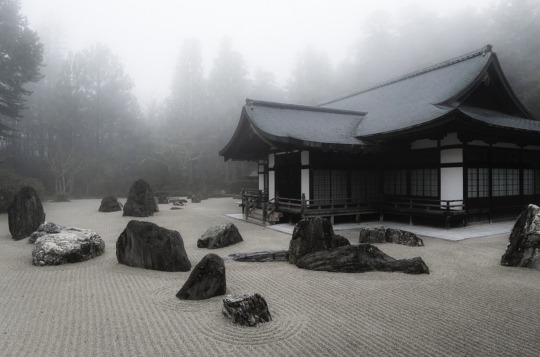
Kongōbu-ji Temple
721 notes
·
View notes
Text
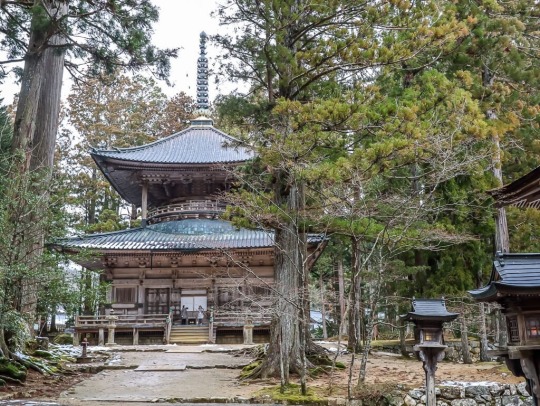
Koyasan - The Sacred Mountain of Shingon Buddhism
Nestled amidst the serene forests of the Kii Mountains in the north-eastern part of Wakayama Prefecture, south of Osaka, Koyasan, also known as Mount Koya, is a place of profound spiritual and historical significance. It is one of the three sacred sites, including Yoshino and Omine, and Kumano Sanzan, that are interconnected through ancient pilgrimage routes leading to the historic Japanese capital cities of Nara and Kyoto.
Koyasan is a place where time seems to stand still, where nature and spirituality blend seamlessly. This site is not merely a testament to religious devotion but also a reflection of the harmonious fusion of Shinto and Buddhism, two of Japan's most influential belief systems. Shinto, deeply rooted in Japan's ancient tradition of nature worship, coexists with Buddhism, introduced to Japan in the 6th century from China and the Korean Peninsula.
The origins of Koyasan's spiritual significance can be traced back to as early as the 9th century when several shrines were established, some predating the arrival of Buddhism in Japan. These shrines symbolize the rich tapestry of Japan's spiritual heritage and the coexistence of various belief systems over the centuries.
At the pinnacle of Koyasan stands Kongobuji, the principal temple of the esoteric Shingon Buddhist sect. Founded in 816 by the revered monk and scholar Kukai, also known as Kobo Daishi, this temple serves as the heart of spiritual practice in Koyasan. Kukai's vision transformed Koyasan into a sacred mountain for ascetic practitioners, and his legacy endures through the Shingon Buddhist tradition. Koyasan is home to a Designated National Treasure, featuring over 120 temples, each contributing to the spiritual ambiance and cultural significance of the area.
One of the most striking features of Koyasan is its Inner Sanctuary, which houses a vast cemetery, including the mausolea of many renowned figures in Japanese history. Among them is the final resting place of the 16th-century samurai ruler, Toyotomi Hideyoshi. This cemetery is not only a place of historical importance but also a testament to the enduring reverence for ancestors and the continuation of sacred traditions.
Koyasan is also marked by the grandeur of its Daimon Gate, which has stood as the main entrance to the temple complex since its inception. This gate, standing at a remarkable 25 meters in height, welcomes pilgrims and visitors alike, symbolizing the enduring spiritual journey that Koyasan represents.
Today, Koyasan continues to be an integral part of Japan's living culture. It is a place of deep spiritual connection and tranquility, attracting approximately 15 million visitors annually. The temple offers lodging facilities for pilgrims and visitors, allowing them to experience the serene ambiance of Koyasan and partake in its spiritual heritage.
In conclusion, Koyasan, with its rich history, spiritual significance, and cultural importance, stands as a testament to Japan's enduring reverence for the sacred and the coexistence of diverse belief systems. It is a place where the past seamlessly merges with the present, offering a unique and deeply enriching experience for all who visit.
12 notes
·
View notes
Photo

Crabapple Styled after Kongobuji Temple Cherry Tree~
Earlier I posted photos from a screen at Kongobuji Temple in Koyasan. It quite caught my eye and inspired me to style a tree in its likeness. Returning home from Japan, I was fortunate to acquire a native crabapple tree that had a similar feeling to the trunk. So here is my Kongobuji Tree, first styling. The branches are quite soft still, so I didn’t dare wire them, instead gently pulling them down with wires looped around exposed roots.
5 notes
·
View notes
Text
Blog 16
Koyasan - A Rainy Journey to Kobo Daishi's Mausoleum
After leaving the Kongobuji temple, I made my way down to the Danjo Garan complex. This is the biggest complex of temples in Koyasan and arguably the most important as it's the first temple complex that Kobo Daishi built. The interior of the temples were majestic and grand and although photos were not permitted inside the temples, the image of the tall Buddha statues and enormous wall paintings and mandalas are etched in my memory. After I spent a good hour there, I journeyed towards Kobo Daishi's Mausoleum that lies at the end of Okunoin Cemetery, the largest cemetery in all of Japan. The route through the cemetery to the Mausoleum was highly spiritual and contemplative. Reaching the Mausoleum after a 2km walk was a rewarding experience. At the resting place of Kobo Daishi, there were a number of devotees chanting, burning incense and praying. I am very honoured and glad I got to experience the walk and interior wonders of the temples I visited in this historical and beautiful place.






0 notes
Photo
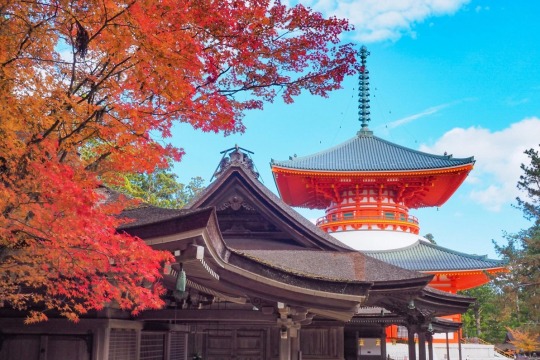
高野山 和歌山の名所
高野山(こうやさん)は、和歌山県にある、真言宗の総本山であり、仏教の聖地として知られています。標高約900メートルに位置し、霊峰としても親しまれています。 高野山は、空海(弘法大師)によって開かれた寺院群で構成されており、密教の修行や研究の拠点として栄えました。現在も多くの寺院が点在し、厳かな雰��気の中で修行僧や参拝客が訪れます。 高野山の中心には金剛峯寺(こんごうぶじ)があり、この金剛峯寺を中心に、大師堂や総持寺、宝戒院など、多くの重要文化財や名刹が存在します。 また、高野山は霊峰としても知られ、山岳信仰の対象となっています。美しい自然が広がり、四季折々の風景が楽しめます。特に紅葉の季節には、山々が美しい紅葉色に染まり、多くの観光客が訪れます。 高野山には一般観光客向けの宿坊もあり、参拝や体験プログラム、精進料理を提供しています。また、霊山巡礼を求める人々や仏教信者の修行の場としても知られており、その厳かな雰囲気や豊かな自然に触れることができます。
♪♫♬🎤🎹🎶♪♫♬🎤🎹🎶♪♫♬🎤🎹🎶♪♫♬🎤🎹🎶
Koyasan Famous places in Wakayama
Koyasan, located in Wakayama Prefecture, is the head temple of the Shingon sect and is known as a sacred place for Buddhism. Located at an altitude of approximately 900 meters, it is also known as a sacred mountain. Mount Koya consists of a group of temples founded by Kukai (Kobo Daishi), and flourished as a base for training and research in esoteric Buddhism. Today, there are many temples dotted around the area, which are visited by monks and worshipers in a solemn atmosphere. Kongobuji Temple is located in the center of Mt. Koya, and around Kongobuji Temple there are many important cultural properties and famous temples such as Daishi-do Hall, Sojiji Temple, and Hokaiin Temple. Mt. Koya is also known as a sacred mountain and is the subject of mountain worship. Beautiful nature spreads out and you can enjoy the scenery of each season. Especially during the autumn foliage season, the mountains are dyed in beautiful autumn colors and many tourists visit. Koyasan also has a lodging house for general tourists, offering worship services, experience programs, and vegetarian cuisine. It is also known as a place of ascetic training for people seeking sacred mountain pilgrimages and Buddhist believers, and you can experience its solemn atmosphere and rich natural beauty.
0 notes
Text
Embracing Silence: A Komuso Monk's Quest for Anjikan Meditation. Part 2 - reality
As I said in the previous post I took a trip to the famous Mt Koyasan, to experience Anjikan Shingon meditation. This part is the real story, how ever just a part of the story which will be on the other blog, This part is more of what I was experiencing as a Komuso. Besides liking the vibe of Koyasan, I wanted to experience Anjikan Meditation and stay at a Temple nearby to Kongobuji temple where…

View On WordPress
#Blasain#Blasian#Buddhist#Ch&039;an#Chan Priest#flute#Honkyoku#Japan Temple#Japanese culture#Japanese music#Japanese Temple#Komuso#Myoanji#Shakuhachi#Sui Zen#SuiZen#Traditional Japan#Zen#Zen Priest
0 notes
Text
17/5
Kongobuji
We visited one of many temples on Koyasan. In fact, it was our only temple visit. Kongobuji allowed walk-throughs and photos when it was aiming outdoors versus indoors as with some other locations we visited due to light sensitivity of the old sliding doors. It was interesting once we came upon the old kitchen at the end, which was my favorite part. This place also had a modernized extension area where guests could rest up and have a drink as well as listen to orientations.
After this we walked to a museum that was nearby and just across the street. It also happened to be National Museum Day so we also received a free postcard with our tickets. Inside were two buildings, both holding Buddhist scriptures, primarily of Kukai. There was also the yearly Kanji written by the Showa Emperor.
Cemetery Walk
Our inn at Koyasan no longer offered free cemetery walks, so we took matters into our own hands and had an abridged version in a sense. We did one midday, that I did not take part in, and one at night, which I did take part in. The nighttime tour was very creepy and hard to see beyond what was lit up by old lanterns and occasionally newer streetlights which were few. At the end we reached the Great Hall, which had its start in being for the deceased of natural causes, etc, as well as where the Buddha was said to be in stasis until he awoke.
0 notes
Text















Day 9
W 5/17 Nara ► Koyasan PM ֍ Kongobuji/Garan ֍ Reihokan Museum ֍ Okunoin Cemetery Night Tour [Eko-in Shukubo]
On day 9 we spent the majority of the time getting to Koyasan. When we first arrived at Ekoin the first thing that jump out at me is the beautiful aesthetic garden surrounding the Inn. The inn is also a small temple that is been maintained by the monks that lived there. The room was very big and open with a sliding door that lead straight to the outside garden. We all spent a lot of time admiring nature's beauty on the porch in front of the house and enjoying a delicious vegetarian dinner prepared by the Inn. The food was very well-balanced and delicious, especially the mini hot pot that we have. Overall, I really enjoy the meal and it left me with a refreshing and rejuvenating feeling at the end. This inn even though it was a traditional inn with a bathhouse similar style to an Onsen, the bathroom was surprisingly modernized. That to me was a relief because I would not enjoy a squad toilet. I also got a chance to do some meditation although I was struggling trying to stay awake since I was so tired.
Later on that night, we all went to the Okuoin Cemetery Night Tour. Because the price become so expensive our Professor give us the tour instead. Before going on the tour I was expecting a graveyard similar to the American one not knowing that the road of the Graveyard leading up to the Okunoin Temple. The road was pretty well-lid with many people doing the same tour as us so it was not so excluded. Furthermore, the temple was very beautiful especially at night with all the lanterns. Lastly, the music at the end on our way back was a little creepy but we realized that it was just the town bell.
0 notes
Photo

Kongōbu-ji Temple, Mount Kōya, Wakayama Prefecture, Japan
#Japan#Kongōbu-ji Temple#Mount Kōya#高野山#Kōya-san#Wakayama Prefecture#Kongobu-ji Temple#Mount Koya#Koya-san#Kongobuji Temple#Winter#Nippon#Architecture
2 notes
·
View notes
Photo

The Chigo no Ma room (稚児の間) within Kongōbuji Temple (金剛峯寺) on Mount Kōya (高野山) in Wakayama Prefecture, traditionally used for overnight guard duty during imperial visits, decorated with screen paintings rendered by Yamamoto Tansai (山本探斎) during the 19th century and graced with a sculpted image of Jizō Bodhisattva (地蔵菩薩) donated by the family of the prominent statesman Soejima Taneomi (副島種臣) (1828-1905) enshrined on the left
(click to enlarge for better detail)
Image from the temple’s official website
#buddhist temple#和歌山県#wakayama prefecture#高野山#koyasan#mount koya#高野町#koya town#金剛峯寺#kongobuji#真言宗#shingon#japanese art#襖の絵#襖絵#fusuma e#山本探斎#yamamoto tansai#狩野探斎#kano tansai#地蔵菩薩#地蔵#jizo#japanese history#副島種臣#soejima taneomi#interior design
17 notes
·
View notes
Text
Day 22 | Visiting Koyasan-Okunoin, Kongobuji and Hojo-in (and night with the giant spiders)

Hey guys! I have 3 more days out of 29 left to describe adventures from my trip in Japan. I would like to continue with Day 22 when I was already in the camp, my fourth day with the campers, and our next locations were several temples and the traditional hotel somewhere in the mountains of Wakayama-prefecture. This includes going to the Okunoin temple which is part of Koyasan area, followed by the lunch and visit to the Memorial Monument of Lions Club, then a buse ride to Kongobuji temple and lastly to Hojo-in temple and the hotel which behaved literally like Dr Jekyll and Mr Hyde.
Unfortunately I do not believe you will be able to read about this day with plenty of information as I will not have enought time, we visited so many places each with its own story and so many things happened I would have to break it into two posts. However, let me try to keep it short.
Visiting Koyasan-Okunoin
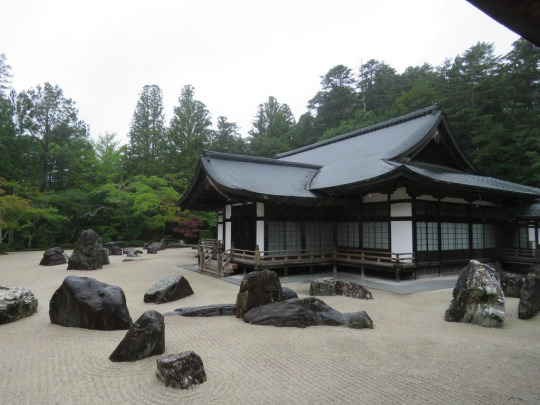
We left our hotel in Osaka after spending a day at the Universal Studios Japan. What it was like you can read and see in three of my reports. After breakfast we left for the temple of Koyasan where the trip lasted for almost 3 hours. What I remember while arriving there is that it is a part of the larger complex with several temples. It was all suggesting we were going to have an awesome time today, especially if you are a fan of the Buddhist temples, rituals and walks through the forest. Unfortunately, it was raining practically the whole day that even extra umbrellas were needed to survive. All of these places are located in Wakama Prefecture maybe just about on the half of the way between Osaka city and Wakayama (a bit closer to Wakayama though).
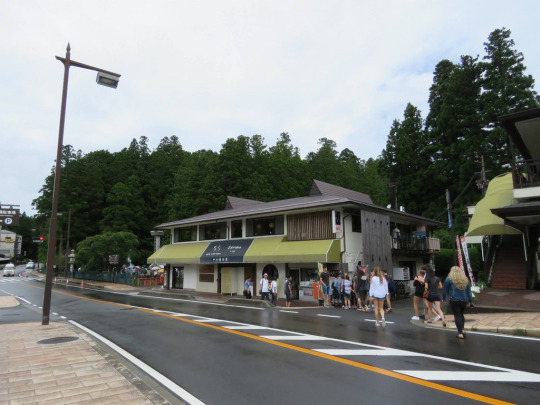
Okunoin temple (part of the Koyasan area) and the especially the area and the path leading to it are just amazing. I had to have a look at all of my photos and on the internet to remind me and there is just so much to tell you about.
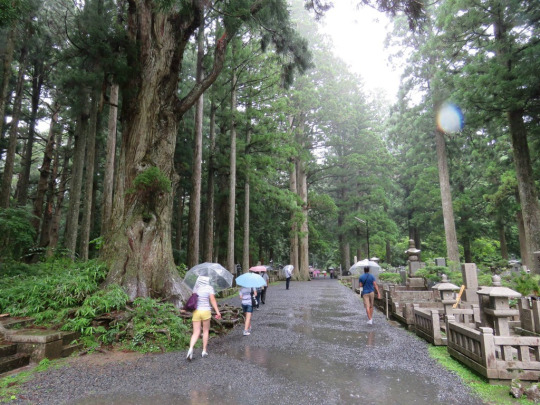
The path that leads to it is maybe half an hour or more long and you are walking among thousands of little temples, shrines and the tombs throught the forest. All in gray and green. Here is where I learned about the red clothes put on the sculptures or columns at the cemetires that actually show that there was a baby or a child that died.

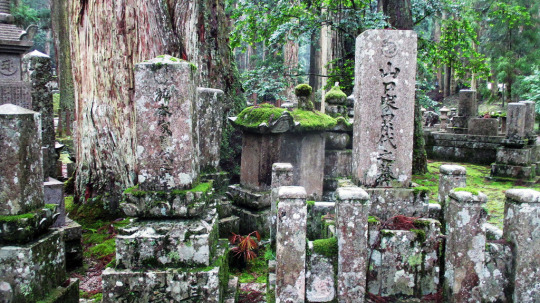

One of such places were several big pyramides of little sculptures and plenty of colorful rags or scarfs put aruond them. For a moment one would have thought to be in some other country as this with the pyramides was strange for me to associate with Japan. While walking through the forest of the very tall trees we end up across several smaller bridges in front of the stairs that climb on a hill.
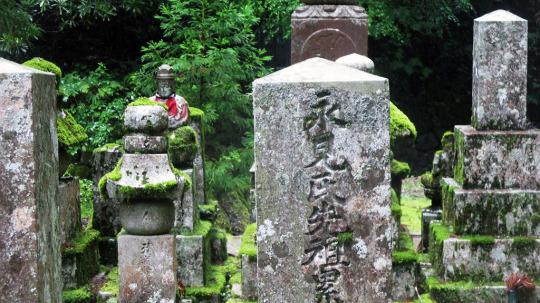
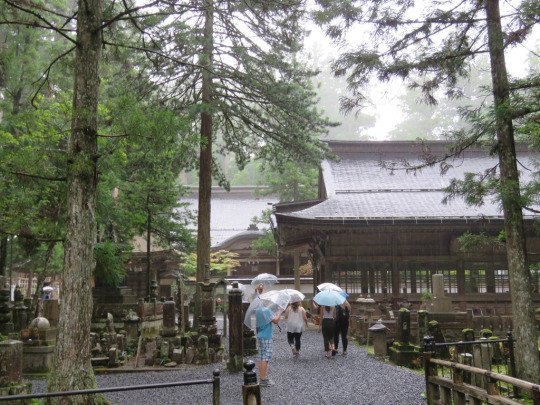

Behind the enormous dark gates upon the stairs one finds the huge temple, also in dark colours, that was surrounded with so white stone that almost looked like snow!
We entered the temple and what I noticed was the ceiling full of hundreds of little lanterns. We had a priest there who showed us a little bit things around and we came across a book where you could write a message referring to the luck or wishing someone luck. It was not a guestbook of course and I saw that noone really wrote stupid messages there as we use to while visiting some places. Alongside the book were many of amulets or luck artifacts with kanji on it. On some of the wooden sticks even one could write a message but since we knew no Japanese except for few friends most of us did not touch it. There was also a donation box which is quiet normal for all the sacret places in Japan to have. Unfortunately, we were not supposed to take photographs of the interior...
Lunch and the Memorial Monument of Lions Club

We went then back for the lunch at the big restaurant house near the parking lot. There was some other large building close by that might have been a train station. After lunch (and this time meal was difficult for us) we were supposed to visit the Memorial Monument of the Lions Club when it started to rain heavily. We had to bring more umbrellas from the bus to help the others without it. It took us about 10 minutes of walking till we reached this cemetary and the Memorial Monument in the middle of it. We spent there several minutes and commemorated the dead members of the Lions Club. The Japanese cemeteries look a bit different from ours. While we prefer to have the horizontal epitahs with the name and the text written horizontally in Japan the columns are being preferred with the text (signs) written vertically. What I also noticed was that many of these columns had a hole at the top whre one could put a candle. And the top of it then was closed by a little roof that looked like a square or the roof of the temples.

Visiting Kongobu-ji temple

Our next destination was the temple of Kongobuji which is maybe the biggest temple we have been to and covers pretty large area. I remember the white sand aroudn the path after passing the huge gates and then the classic – taking of the shoes and leaving them at the wooden stairs. Walking then through the hallways that were connecting the rooms and halls (maybe everything on some kind of a platform) in the socks until we were asked to sit down in one hall and ... wait for the tea and cookies. That is what I remember more or less.
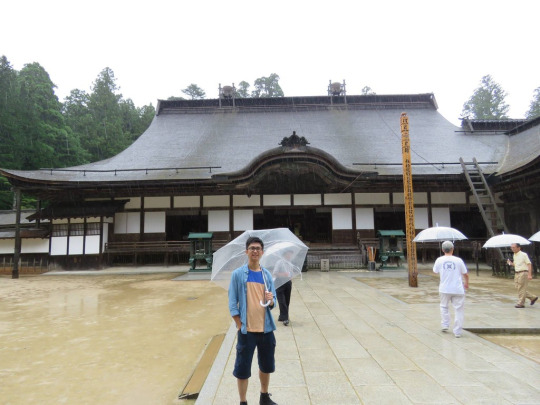


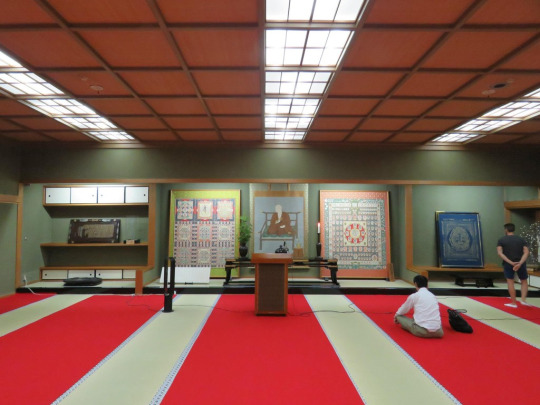
The last stop today was the hotel and the temple Hojo-in where I do not remember anymore the temple and whether we visited it or not but very much the hotel we stayed at. On our way there we stopped once at Lawson store to get some snacks which turned into a big shopping madness. Mr Toru told us we do not have to spend our own money and bought us everything! I also saw there the „magazines for the adults“ and was laughing. I could not pick inside as all of them are packed in the plastic foils and unless you buy them it is not possible. I did it for the purpose of journalism of course.
Hojo-in hotel

The rain started again as we were leaving with our bags from the bus to this temple. It was night already but the place looked big. Unfortunately no time to go around it even in the morning but the hotel and the temple had an enclosed yard with nice garden and rocks lying around. Oh, I forgot to mention that at all the Japanese temples have rocks lying around the yard but always somehow balanced. I believe they represent something with the energy and energy points forming some balance in the nature and among the architecture.
At the entrance of the house we had to leave the shoes again and put them into the wooden racks on each side of the racks. Then we got the number of the room...or just headed to any room we found. I was in the room with one of my best friends there – Ugur from Turkey. Now the hotel was pretty interesting, the whole compley actually. One half of this huge building had about 3 floors in total with many „hidden“ hallways that were like a labyrinth. There was one space where one could sit on the sofa and even catch wi-fi signal when lucky. We were walking with our smartphones in the air trying to catch the signal like the scene from the Lions King, haha.

The rooms here were of course traditional and the „locals“ (the priests) here were wearing their kimono I think the whole time we spent there. The walls of the rooms were pretty thin and you could hear the others several rooms away so talking here and secrets was not going to pass. There was a wardrobe with the doors that open to the left and right (and the doors of the room too) and had plenty of blankets. We had two mattresses on the floor and also a place to charge our electronics. There were large windows and we closed them both not wanting rain to get it. It proved to be a very smart decision that evening, as you are going to find out.

We had a dinner in a large hall on the first floor (next to the entrance) sitting in severalr ows on our knees on small pillows. I could not take it anymore and chose to sit in what we call in Croatia „sitting like Turk“ posture with both legs crossed. We had now opportunity to eat Vegerian only meal as that was the practice at this temple. It was quiet delicious even without meat (I am a carnivore btw) and we did not feel hungry. Again a bit of everything on the plate. There was one problematic part that was impossible to stay still when using the chopsticks, something white that looked like a pudding, and always fell down in the bowl. It took me 5 minutes before it stopped falling.
We thanked the hosts for dinner and then had country presentations. One had to be careful not to lay with their back on the wall behind because it would get damaged easily. Another potential „danger“ and a problem were the doors to this large room or hall as some of us were much taller and could get hit in the head like Gandalf in Bag End.
We had now about 2 hours of free time before going to sleep and it was not boring indeed. What should I mention first? Let me see...getting lost around the building and discovering large halls in the basement (in the dark!), hunting down and running away from the spiders of a size of a tennis ball, going for the shower for the first time in the „public“ baths with other guys naked...
After roaming around with friends and checking every floor and the floors (and since there were very few other guests besides us it was pretty spooky to go walk around alone) we found those baths and probably the strangest toilets I have ever encountered. There were two doors – one for men and for women...but then instead of having a wall between each other the toilet in the middle (khm, for „the big need“) was shared by both! You could literally pass through the men's restroom into women's just by going through that cabin in the middle, insane! haha There was also a room with sinks where one could shave or brush teeth in peace. I did it, being alone on the whole floor waiting for the monsters to attack me. And right now remembered another toilet non of us did not want to use. The place where you are supposed to sit while peeing or the other thing ... was just a hole in the floor! I was wondering how that was even possible to do without falling on your back and rolling around. And there were sveral holes (or let's say these „sophisticated toielts“ ) in the row meaning you could have been with the others. No privacy, no toilet paper and no toilet bowl. Never iagined that. There was a pretty normal and modern restroom on our floor of course. But that downstairs is like walking through some museum.
Then my roommate and I decided to go in the last 15 minutes before its closing to the shower room as we thought „We are going to have to do this within few days at this Inunakiyama Onsen so maybe try it now when there is not many people around to break the ice.“. So we did there and it was first strange but once you stop caring nothing abnormal. We spent 5 minutes there and one of the campers was also there I believe (but could not recognize him without glasses) who asked us „hey guys, what are you laughing about?“ but he could not understand it from our point of view.
The last thing to mention were the hueg spiders that scared the *thing* out of everyone. You remember me mentioning it was a wise decision to close the windows in our room? Well, the others did not do it.
What happened and how we survived it (and if we did) coming soon.
Plans for the other day
There was an ascetic practice in the morning for the brave ones who wanted to wake up around 6am. I was sleeping. Then we went more to the south to famous Shirahama and spent the day at the Shiraham White beach, were supposed to watch the fireworks and have a karaoke evening in the hotel.
Thanks for reading.
Photo credits go to the Lions Camp Osaka counselors and the campers (Jesse Tucek).
1 note
·
View note
Photo

Creating…
When we work on a tree,
Are we crafting a stylized version of itself?
Creating a sculpting?
Or capturing the essence of the tree and nature?
Perhaps sometimes it is one, perhaps the next time another?
Can it be all three at once?
In the past I’ve looked at Song dynasty paintings for inspiration. The very same paintings that gave rise to the Bunjin or literati style I’m fond of.
Presented here is a screen with a beautiful twisted cherry tree. It is one of many screens at Kongobuji in Koyasan. If it were an actual bonsai, no doubt it would be considered a masterpiece. It most certainly has been an inspiration for work on a crabapple tree I just acquired…
#bonsaitree#bonsai#bonsaipenjing#penjing#japanesescreen#japanesecherrytree#swordsmanbonsai#scottrodell#scottmrodell#penzai
2 notes
·
View notes
Photo

Winter at Kongobuji Temple in Koyasan. Photography by wasabitool(H.Fujinami)
@wasabitool
73 notes
·
View notes
Video
<strong>Okunoin shrine. <a href="https://www.flickr.com/photos/mzagerp/">by mzagerp</a></strong>
Koya-san, japan.
#japon#japan#honshu#temples#bouddhism#asie#asia#july#august#2017#travel#voyage#roadtrip#koyasan#okunoin#kongobuji-in
2 notes
·
View notes
Text







Découvertes des six principaux temples de Koyasan (deuxième montagne sacrée au Japon). Nous commençons par celui de Kongobuji dont le premier édifice a été érigé en 1593.
3 notes
·
View notes

